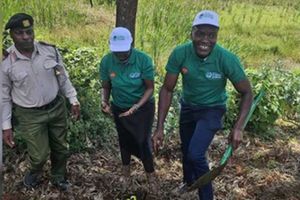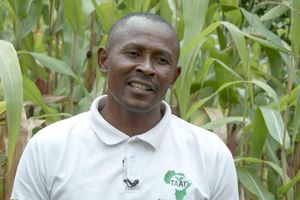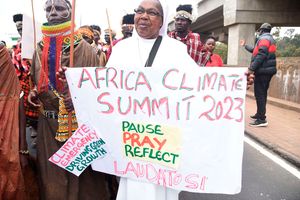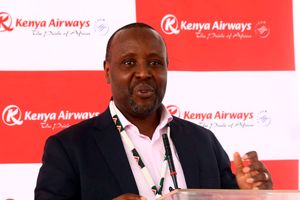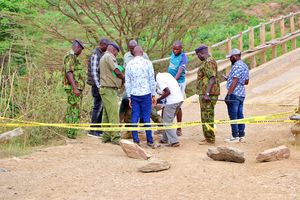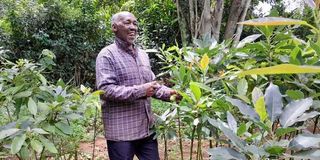
Joseph Kabere Ndonga at his two- acre farm with a seedling that has already started producing fruits. Proper grafting and enough soil nutritions accelerates fruit maturity and high yields.
It is sunny as we drive towards Uplands from the Redhill side, past Limuru and then onto the Nairobi-Nakuru highway.
The scenery is beautiful with different types of trees, fruits and vegetables. A few minutes later, we turn right to the Uplands-Githunguri-Ruiru road.
The neglect of the road is telling. Less than two kilometres down the road, we come to the Uplands Bacon Factory, now a ghost.
A few metres down, we turn left and then right before stopping at our destination.
The place stands out. There is a lot to see – many tree species.
A man in rubber boots, with a pair of scissors, emerges from the bush: “Welcome to Lari Agroforestry and Reforestation Project or Larep Kenya as most people know it. This is a place of many activities,” he says.
“My name is Joseph Kabere Ndonga. I retired from the Ministry of Livestock in 2018.”
Also Read: Why dragon fruit is Kenya’s next gold
With so much going on, a guide is necessary. There are many indigenous trees, fruit trees and flower nurseries around.
Metres away, a customer is cutting suckers from an avocado tree to graft to her seedlings.
The grafting material, commonly known as the scion, must come from a high quality plant. A customer is first shown the necessary steps in grafting to achieve the desired results.
“If you follow the instructions, your grafted plants will produce high quality fruits and reduce the maturing time. If an ordinary tree takes two years to produce fruits, a grafted one will take about a year with increased harvests. That means high quality, better yields and more,” Ndonga says.
This is one place where hunger is kept at bay, thanks to Ndonga’s diligence and generosity.
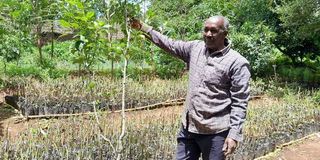
Joseph Kabere Ndonga explains how different species of a particular fruit can be grafted to increase both quality and quantity.
Fruits are known to contain vitamins that help ward off many diseases. To increase knowledge of the health benefits of the many varieties of fruits, vegetables and other plants, Ndonga is always engaged in online research.
As technology advances, researchers are finding more health benefits in fruits, vegetables, tree crops such as Prunus Africanas (Muiri in Gikuyu) and others, including grains.
Knowing how to get these things and how to use them properly can reduce hospital visits. Indigenous trees on Ndonga’s farm include Mutati and Mutamaiyu.
The fruit trees include William, Packham and China pears. Pears are usually grown from November to June, Ndonga says. Depending on variety, they are harvested from December to April.
Ndonga grows more than 10 varieties of plums, including Victoria, cherry and cooking types. He says it is important for customers to understand the variety and in order to manage the plants correctly.
The most expensive seedling at Larep Kenya is Canistel (Egg). The largest goes for Sh7,000, the farmer tells Seeds of Gold.
The fruit has a high medicinal value, including anti-inflammatory and anti-microbial properties. It also improves digestion, boosts immunity and is full of minerals.
There are a variety of peaches to choose from at Larep Kenya. Gooseberries are also available in large numbers.
“These fruits contain zinc and are generally good for a healthy body, especially for men,” he says.
Six regional programmes
Ndonga also grows many types of cacti for decoration. Among the flowers at Larep Kenya is the bottle bush.
Ndonga’s farm has also become a learning centre. The people or groups that visit the farm to buy seedlings, fruit and flowers are shown how to take care of them.
The retired civil servant says Larep Kenya has donated tree seedlings to Githirioni and several other primary schools.
More than 2,500 seedlings have been donated to the educational institutions. Parents of Githirioni Primary School have also been receiving seedlings. Gituamba Primary and Secondary Schools have received more than 1,000 indigenous and exotic tree seedlings from Larep Kenya.
“We have donated avocado seedlings to Nyamweru Secondary School and many families in the neighbourhood. The farm usually extends donations to bereaved families, especially in the form of flowers as part of our corporate social responsibility,” he says.
“I advise those celebrating anniversaries like birthdays to plant trees as a way of remembering and preserving the environment. Many schools send children here to get information on environmental issues.”
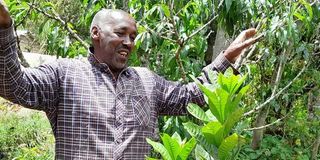
Joseph Kabere Ndonga near the high nutritional and medicinal value of Canistel (egg) tree fruit.
Ndonga encourages educational institutions and religious organisations to visit Larep Kenya for learning experiences that he says would benefit individuals, families, the community and country.
He teaches young people how to start nurseries, encouraging a sense of responsibility for improving the environment and self-reliance.
“I also advise those who visit Larep Kenya to learn about grafting and seedling budding. In this area, many people earn their living by providing services to those who want to have their fruit trees grafted,” he says.
“When, for instance, an avocado is charged Sh10 for grafting, and there are 400 plants that can be grafted in a day, you know where your bread is buttered. If you can learn just one area of grafting, you will succeed in life as there are many people who need such services. You also improve your own area as you gain more knowledge over time.”
Visitors, who include foreigners, are encouraged to plant trees as a memento.
Among those who have planted trees at Larep are Virgila Constantin, Cyrille Bllas from Geneva, Switzerland, Staffen Anderson from the University of Sweden and Lars Rebane from Alarp also from Sweden.
While the initial stages of improving the Larep Kenya nurseries were challenging due to the lack of key facilities, Ndonga’s efforts have attracted visitors from far.
TV stations with farming and environmental programmes have helped many Kenyans and foreigners learn modern farming methods at Larep.
Through media exposure, the farmers have learnt from one another, spreading the benefits to many.
“The water system used here was donated by GTZ after Shamba Shape Up, a TV programme highlighted our achievements, challenges and needs. That was about six years ago,” Ndonga says.
He believes in constantly seeking knowledge to improve his farm. Among the institutions that have played an important role in helping individuals and groups involved in tree nurseries project is the Centre for Research in Agroforestry (Icraf).
The Nairobi-based organisation runs six regional programmes in sub-Sahara, Asia and Latin America.
It also conducts research in more than 30 other centres in the developing world.
Ndonga says Icraf field employees would visit farmers to exchange views and learn to improve their nurseries.
Because of this, nursery owners started coming together for seminars hosted by Icraf.
The centre also organised trips. During the tours, nursery operators would donate seedlings to be planted in selected areas like Ngong and Athi River.
Ndonga says it helped create more awareness on the need to plant trees in an effort to improve the environment and address the effects of global warming.


